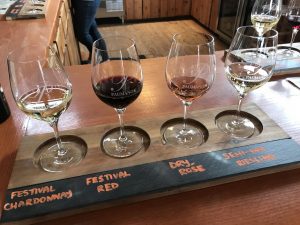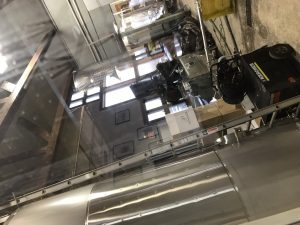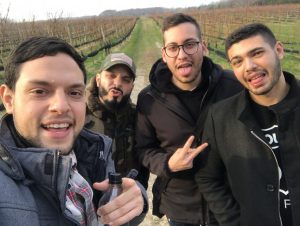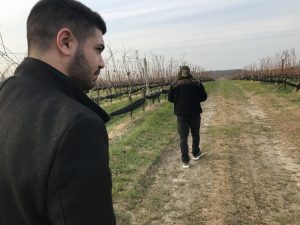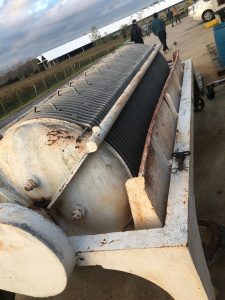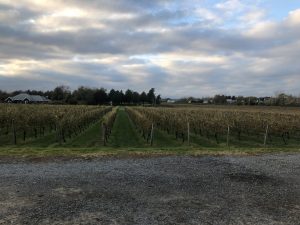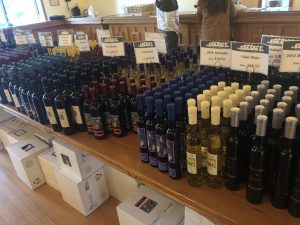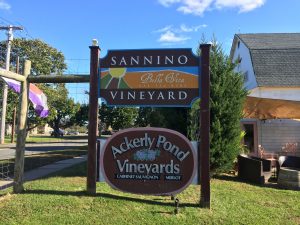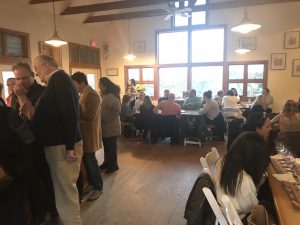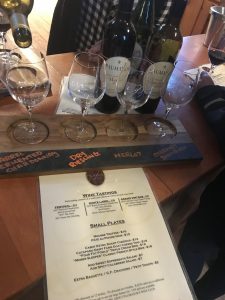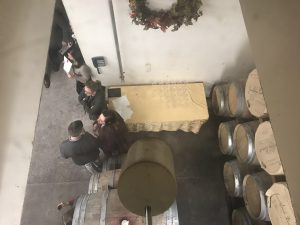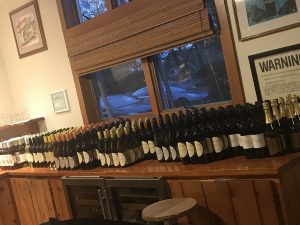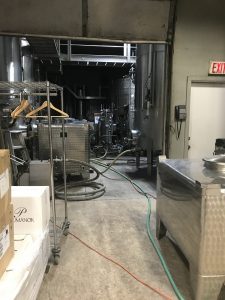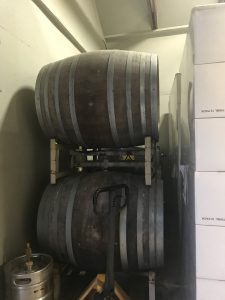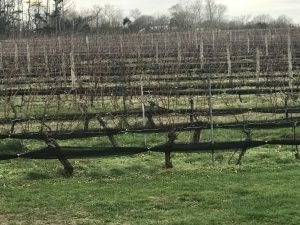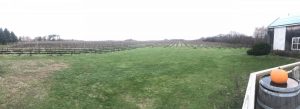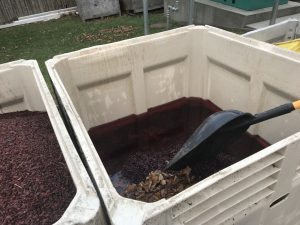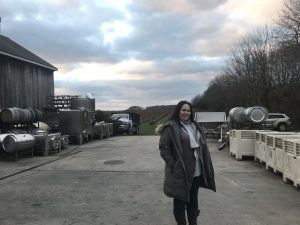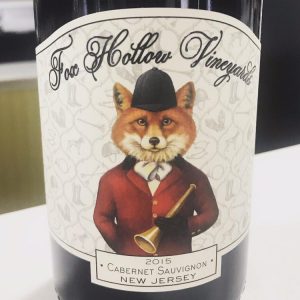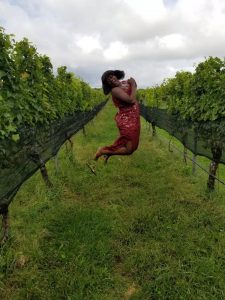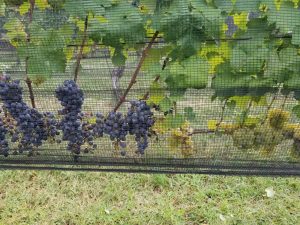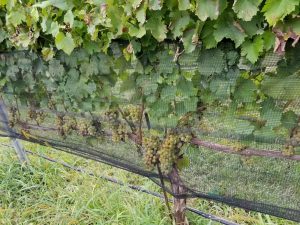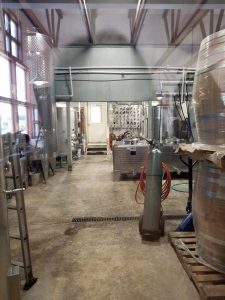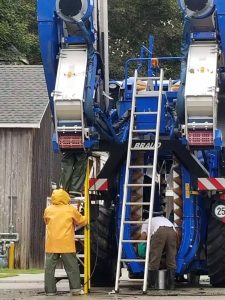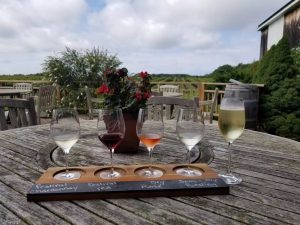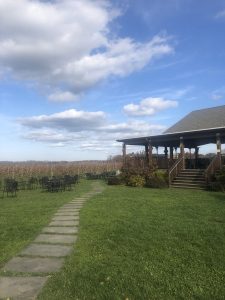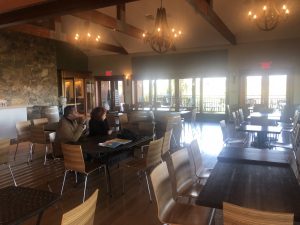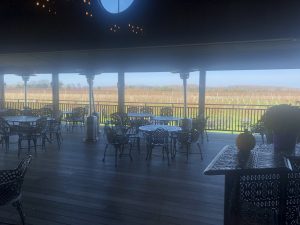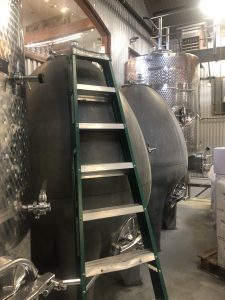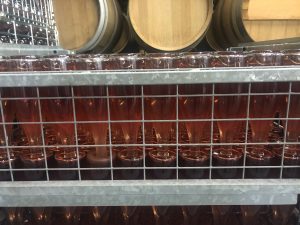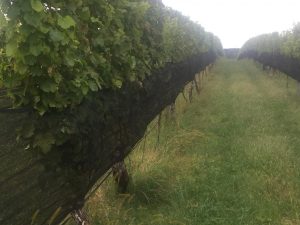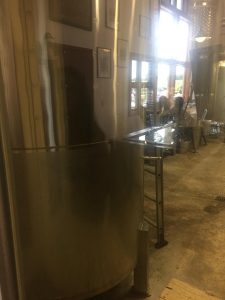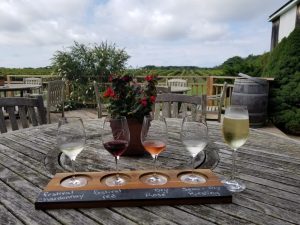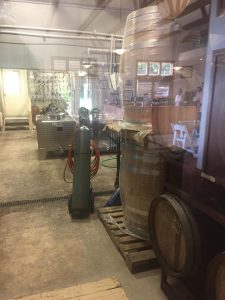The winery that I visited with my friends was called “Sannino Bella Vita Vineyard” located at 1375 Peconic Ln, Peconic, NY 11958. The Sannino Vineyard is included in the American Viticultural Area (AVA) called North Fork AVA in Long Island. The Sannino Vineyard offers educational tours costing $50 per person, hence the reason we chose to visit this vineyard. 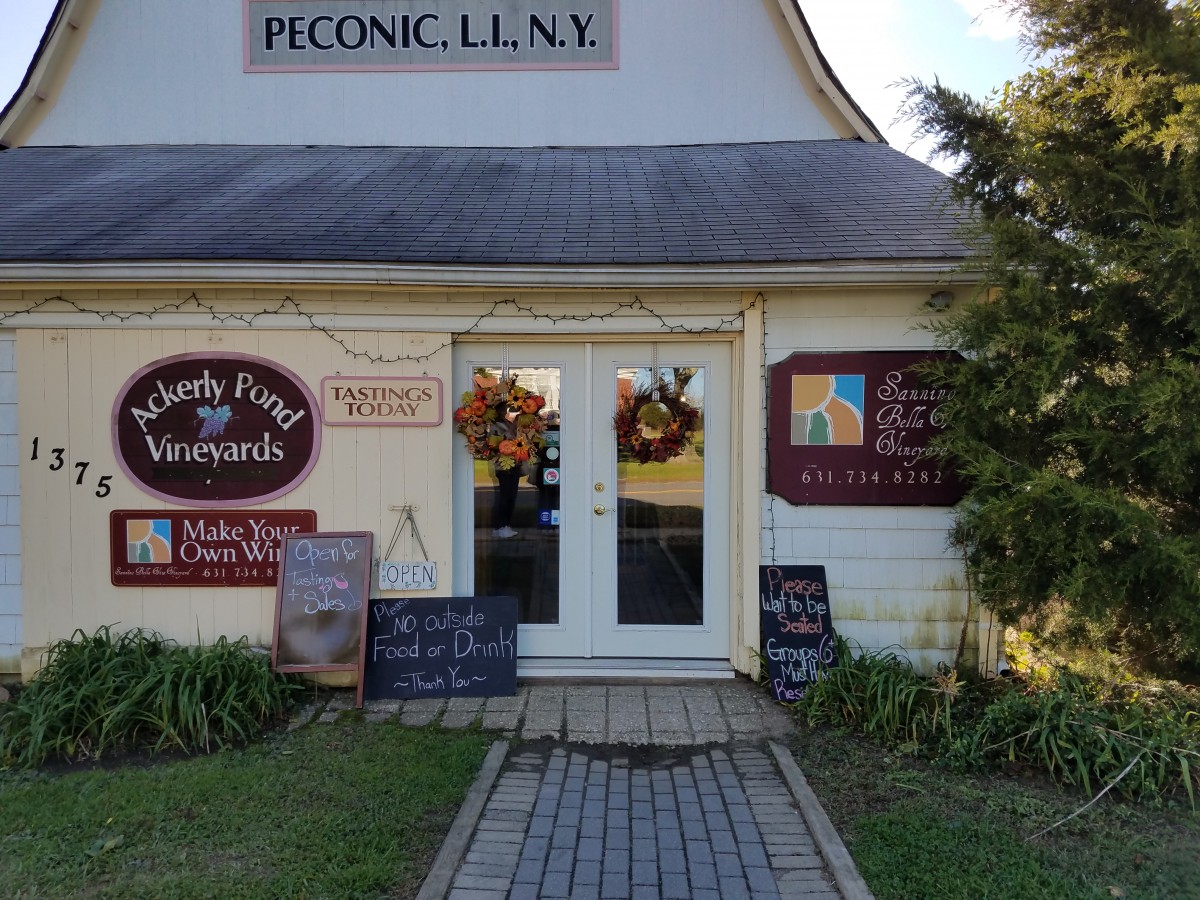 Continue reading
Continue reading
Category Archives: Winery and Vineyard Visit Blog
Walks along the Paumanok
Wine Beverage Analysis
By: Luciano J. Sorrentino
For this assignment, I had the privilege to visit a vineyard in Long Island.
Long Island is a peninsula two hours east from Manhattan, New York. This place is home to great seafood, hikes, aquatic sports, history, but one quality sticks out amongst the rest, Wine. Viniculture is the study of growing wine and they seem to do a pretty superb job. I recently investigated one winery by the name of Paumanok Vineyard. My initial impression of the place was underwhelming, per the coziness of the wooden barn. I automatically retracted from this first impression upon opening the front door, it gave off this warm, quite, and hospitable vibe. We were greeted with a warm smile by everyone. The barn consisted of a fully equipped wine bar, with one associate and seven tables to choose from indoor and about ten picnic tables in the outside deck facing the Cordones and Canes. What originally brought me to the Vineyards was my interest in Chenin Blanc, which is a rare grape varietal to be grown here on American soil. Originally from South Africa and The Loire Valley of France. Its high acidity means it can be used to make everything from sparkling wines to well-balanced dessert wines. Once widely planted in California, it had largely disappeared from fine wine regions by 2000.”In the last few years, though, at least a dozen California producers have started making chenin blanc, joining a handful who never stopped, along with producers in Oregon and New York”(Times Mag. 1) Only to find out they were sold out upon arrival. No need to weep they had many wine tasting options at a very reasonable price. I was delighted to pick the Festival flat which consisted of four es Festival Chardonnay 17’ I found this option very dry with notes of pear and lime peel. Secondly Cabernet Franc 16’ there’s no other way to put this, the wine was corked or maybe I just got the bitter end of an old open bottle. It tasted like red wine vinegar the bartender seemed to care less, even though I knew deep down she should have poured me another to redeem their reputation. The third wine beverage I tried was a Dry-Rose 17’ yummy with notes of lavender for some odd reason. Last but not least my favorite. A semi-Dry Riesling 17’was well balanced on the palate fruit forward with notes of peached and candy apple. “We had screw caps on big reds from Long Island, a variety of fermentation techniques from Pennsylvania, stem inclusion on cab franc from Virginia, pet-nat and non-vintage reserve wines from Maryland,” said Ed Boyce of Black Ankle Vineyards, picking up on the wonkier parts of the conversation. “Innovation is alive and well”( Washington Post 1).”The Paumanok cultivating practices were Founded in the spring of 1983 and consist of over one hundred and twenty seven acres and follow all AVA laws growing between 1100 and 1400 vines per acre. Production is limited to twelve thousand cases per season, creating a demand for their wines”(Ed.Gov 1). Vinification practices take place in an old barn that went through a modern makeover with a steel fermentation tank and lab. Quite small to be honest. I questioned how they were able to produce such amounts of wine in a small area, in return I received no answer, due to a lack of knowledge of the sales woman. I only wanted to ask more questions when I realizing it was a dead end. This enticed me to read every piece of literature they had on premises. A study was taken to see who were attracted to this industry Data were gathered from 113 of the 502 members of the American Wine Society who attended a national conference in November 1995. About 58percent were male and 43 percent female, 33 percent single and 67 percent married. The majority of those queried reportedly earn over $101,000 per year( Google Scholar 1)
Vineyard Visit by Kazuyoshi Karasudani
On a chilly day in October, I visited two wineries in the Hamptons on Long Island, Wölffer Estate Vineyard and Duck Walk Vineyards. Both wineries are located in the Southampton area. The climate on Long Island is maritime, with cool weather and ocean breezes. The Hamptons A.V.A. was officially established in 2001.
Our first stop was Wölffer Estate Vineyard, one of the best-known wineries on Long Island. On first impression, the winery seemed very stylish, but also very touristy. Wölffer Estate’s labels and bottle designs are different from traditional wines in that they utilize a lot of color and pictures on the bottles, which give their wines a pop culture look. I first decided to visit Wölffer Estate Vineyard because it came with high recommendations from friends and colleagues. I appreciated that Wölffer Estate is trying to be “different” and to stand out from the competition. Upon entering the winery, one can immediately see a set of huge tanks through a window, where Wölffer Estate fermentsits wines. Upon passing this area, there is a gift shop on the left where one can buy Wölffer Estate wines and other goods. The narrow hallway opens to a large dining hall area designed for sampling wines over fresh prepared snacks with friends.
Wölffer Estate offers a tour and wine tasting for $65 per person. During the tour, the guide showed us the property and the cellar downstairs, while sharing information about Wölffer Estate’s history and wine. One thing I specifically liked about Wölffer Estate’s wine is that they use French oakfor several varieties of red wine when aging.Even though Wölffer Estate is perhaps most famous for its Rose, they still putting a lot of effort into their other wines. While the tour and tasting was enjoyable, Wölffer Estate was not my favorite winery. I sampled two different tastings, the Autumn Flight and the Grand Flight, as well as their sparkling rose, but I could not find a favorite wine from the tasting. For instance, while the Grapes of Roth Dry Riesling (2017)was my favorite from this tasting, overall I thought the wine was just okay. The wine is crisp and has a hint of sweetness, but I prefer a more full-bodied wine. I also tried their Claletto Cabernet Sauvignon(2014) that uses the “Amarone” style, meaning the wine is made from partially dried grapes. The wine, which had notes of blackberries, plum and the aroma of French oak, tasted a bit too complex for me.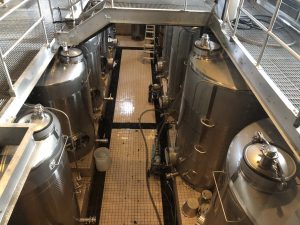
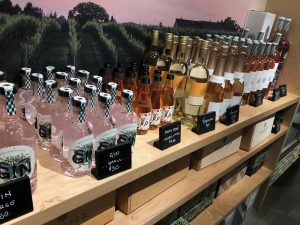
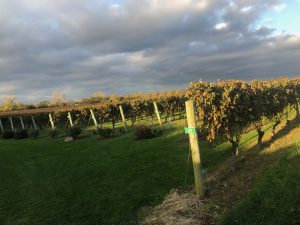
Following my visit to Wölffer Estate, I visited a smaller winery called Duck Walk Vineyards, located a quick ten-minute drive from Wölffer Estate. Originally, my group was not planning to visit this vineyard, but since Wölffer Estate left us feeling a bit disappointed, we decided make a brief stop at Duck Walk. Duck Walk Vineyard was established in 1994. Their flagship location is in Southampton, but they also have another location on North Fork, Long Island, which opened in 2007. Duck Walk owns 140 scenic acres and produces 35,000 cases of wine per year. Their flagship location features 36 acres of grapes, which sit behind a Normandy Chateau-style building in the township of Water Mill. Though it was certainly less stylish and more understated than Wölffer Estates, I personally liked Duck Walk’s building more because it was welcoming with a warm vibe. Their varieties of grapes include Chardonnay, Pinot Meunier, Melot, Pinot Grigioand more. My group did a tasting at their bar. A tasting at Duck Walk costs $10 for four samples. One can pick any four wines from their broad menu and will receive a generous pour. The bartender was very friendly and knowledgeable about Duck Walk’s wines. When I asked him what is “reserve” means with respect to the Cabernet Sauvignon Reserve (2015)(my favorite wine of the tasting), he explained that the reserve means the better grape juice from first flow, or the “free flow. The wine has intense fruit notes such as black cherry and plum, and a very smooth finish. When I told the bartender I was doing research for a class, he introduced me to Mike, who is extremely knowledgeable about wine and about Duck Walk Vineyards. He gave us a quick tour of the grounds. He first told us about the building. The bricks are from Mexico, sand blasted for a weathered look, and entire roof is copper. He then pointed out the tanks that they use for fermentation. The stainless steel tanks hold 5,373 gallons of liquid. Because they are made from stainless steel, they are easy to clean and keep impurities out of the wine. Additionally, each tank has a dimpled jacket, which helps control the temperature of the tanks. Duck Walk does also use seasoned oak barrelsfor aging for some wines, such as their Duck Walk Red Gatsby.
While both Wölffer Estate Vineyard and Duck Walk Vineyard were enjoyable to visit, I much preferred my experience at Duck Walk Vineyard to Wölffer Estate. The staff at Duck Walk were extremely friendly, knowledgeable about their craft and, perhaps most importantly, seemed truly passionate about sharing their wine with guests. Our experience at Wölffer Estate was quite different. In addition to overall better wine, Duck Walk also had a more affordable price range. Overall, I would recommend Wölffer Estate for an outdoor gathering with friends or family during the warm season, and I would recommend Duck Walk Vineyard for a friendly and educational wine sampling and purchasing experience.
References
Andrews, B. (2017, August 02). How Library Wines Help Build a Legacy. Retrieved from https://daily.sevenfifty.com/how-library-wines-help-build-a-legacy/
Certified specialist of wine: Study guide 2018. (2018). Washington, DC: Society of Wine Educators.
GOLDBERG, H. G. (1994, April 03). L.I.’s Largest Winery Bets on the South Fork. Retrieved from https://www.nytimes.com/1994/04/03/nyregion/li-s-largest-winery-bets-on-the-south-fork.html
Wines. (n.d.). Retrieved from http://liwines.com/wines/
Winery visit: Preeya Mayta
For this assignment, I chose to go to Sannino Vineyard in Long Island, New York with Ellies, and Mei. We booked a tour at 12 p.m. Bill Kovacsik who was our tour guide was greeting with a smile and started the tour with a glass of chilly chardonnay. Because of the cold weather, we spent most of our tour in a tasting room. Bill was a former professor at New York University in Singapore. He started the tour with the basic knowledge of wine in general. Deciding on the type of grape to grow is the first step in vinicultural practices. Sannino located in The North Fork of Long Island American Viticultural Area (AVA). Terroir is a site or land in French which play a very important role in this decision making. In Long Island, especially North Fork where the Sannino Vineyard is located, the soli in this appellation is drainage and silt (lisustainablewine.org). Another factor to consider is climate. Long Island is a maritime climate where both Long Island Sound and the Atlantic Ocean cool off the narrow peninsula (lisustainablewine.org). As we all learn in class, water helps to moderate the temperature which is an impact on the quality and the ripeness of grape. Bill mentioned that one of the challenges that vineyards in Long Island have is humidity. Humidity causes mold and mildew. After knowing what type of the climate and soil in Long Island are, then decided to choose the right grape varieties is made. Merlot, Chardonnay, Cabernet Sauvignon are the leading grape varieties in the region (newyorkwines.org).
Moving on to the next step, Vineyard Pruning. Pruning will manipulate the potential of grape produced. Bill told us that the grape vine’s root is about 20 feet deep in the ground. The bud break is the consequent of the pruning system. Just a tip that Bill told us during the tour, how to differentiate American bud and European bud is that American bud is hairy. The last step the Bill mentioned is a harvest. The facts that vineyard manager needs to contemplate are brick level, ripeness of the seed, concentrated berries, alcohol is half of the sugar level, acidity, and tannin. At the Sannino, they offered both oak barrel and tank fermentation. Their oak barrels are from France, America, and Hungary. France oak is thinner than American oak and for the Hungarian oak, Bill said it is cheaper and have a spicy flavor. Red wine from Sannino is fermented in an oak barrel while white and rose are fermented in tank. They age their wine in oak for 22 months for the aroma and flavor. Another fact Bill told us was 80 percent of women are buying wine. The tour also included wine tasting. One of the reasons we chose this tour because of the varieties of wine tasting choices that Sannino offered. Other places only offered either sparkling wine only or red and white wines. The first wine we were tasting was the chilly chardonnay at the beginning of the tour. It was very well balanced with a refreshing touch, perfect for starting the tour. Second wine if I remember correctly was rosé. The next one was an oaky Syrah and following with Cabernet Franc. The last one was unique. It called Spiced Wine which infused with cinnamon, nutmeg, and clove. The wine was served warm.
Resources:
Our soils. (2018, November 21). Retrieved from http://www.lisustainablewine.org/our-soil/
Discover the Long Island Region. (2018, November 21). Retrieved from https://www.newyorkwines.org/wine-regions/long-island
Our climate. (2018, November 21). Retrieved from http://www.lisustainablewine.org/our-climate
Beautiful grape vines (Cabernet Sauvignon)
Experiential Learning Analysis – Chinelle Ann Hooper
Paumanok Vineyards is one of the top vineyards in the North Fork area of Long Island, within an American Viticulture Area (AVA), it was founded in 1983 by winemaker Charles Massoud who is originally from Lebanon, who owns, manages and operates the 127-acre estate – vineyard and winery along with his wife Ursula Massoud who is originally from Germany from the Pfalz.
Paumanok traditionally makes wine from Premium Vinifera grapevines with an impressive range of grape varieties like Riesling, Chardonnay, Sauvignon Blanc, Merlot, Cabernet Franc, Cabernet Sauvignon and Petit Verdot, but Chenine Blanc is the oldest and best. Paumanok is the only winery in Long Island to have grown the grape for many years. The vineyard plants 1100 to 1400 vines per acre to produces concentrated fruit for high quality wines.
Paumanok Vineyards climate is most common with Bordeaux which is very much a maritime climate, as Long Island is an island that extends out into the Atlantic and is surrounded by the Peconic Bay. The soil of North Fork is sandy and gravely subs soil, so the soil drains exceptionally well when it rains. Due to the cool climate the grapes are allowed to have a long ripening period. Due to the weather patterns they sometimes have variation in their vintage, and the alcohol percentages in the white wines are from 11% to 13% and the red wines fall in the range of 11% to 14%. The vineyards are open to different viticulture methods but they follow a simple 100% sustainable vinicultural technique which is to grow the healthiest and plump grapes to make great wine, bottle it and preserve it, the remains are used in the soil which also helps with the flavor. The vineyard has a range of minimalist wines which consists of Chenine Blanc, Sauvignon Blanc and Cabernet Franc.
I visited Paumanok with my friend and mum and was surprised by how big and rustic it looked. When we entered the barn like house we found ourselves in the tasting room which was not very big and overlooked the vineyard and a patio. I was met by an employee who was willing to answer my questions but she had limited knowledge about the vineyard and its practices. She mentioned that we could go and take photographs of the vineyard and the crushing area where I took my picture. When we returned back to the tasting room for a wine tasting, we met Beth, she was very knowledgeable and was able to answer all my questions as well as give me additional information. She mentioned that they make around 10,000 – 15,000 cases of wine in a year.
They had 3 simple tasting menus ranging from $15 to $20. We decided to taste the White Label wines which consisted of
2015 Barrel fermented Chardonnay
2017 Dry Reisling (balanced not too dry or too sweet with a fruity flavor and smooth finish)
2014 Merlot
2016 Cabernet Sauvignon
And a cheese platter
I was unable to tour the barrel tasting room as they had an event, but took a photograph from the glass ceiling of the event in progress.
All the wines mentioned in their list was for sale.
Vinification process they use Oak Barrels and Stainless steel tanks, they bottle the wines on the vineyard with their bottling equipment.
Following vertical viniculture.
When passing the large bins the smell of wine and yeast was strong and surprisingly pleasant. I resisted the urge to stick my finger in the bin.
Paumanok Vineyards. (n.d.). Retrieved November 26, 2018, from https://www.paumanok.com/
The international story behind Paumanok wines. (2013, June 27). Retrieved November 26, 2018, from http://northforker.com/2013/06/26/the-international-story-behind-paumanok-wines/
Climate change creating new challenges for North Fork farmers. (2016, December 21). Retrieved November 26, 2018, from http://suffolktimes.timesreview.com/2016/12/72266/climate-change-creating-new-challenges-for-north-fork-farmers/
Vineyard visit By Veronika Lisetska
Choosing a good bottle of wine can be a challenging job but making a decent bottle of wine is even more hard and needs a good set of skills. It is a different science itself and requires knowledge in agricultural and chemistry industry. For this paper I chose a vinery that is located in Outer Coastal Plain Vineyard Association in New Jersey State. It is named Fox Hollow Vineyards and the exact address is 939 Holmdel Rd, Holmdel, NJ 07733 and its open from Thursday to Sunday from 11:00 am to 6:00 pm. When I asked an employee why it is called Fox Hollow they told me that when an owner was purchasing this land he saw a fox running through the area and thought it was a good sing.
Fox Hollow Vineyard has a total of 94 acres of land. This area has moderate climate that is followed by Atlantic Ocean and Delaware River. Soil type that Fox Hollow Vineyard has its a mix of sand, silt and clay. New Jersey has hot summers and cold winters. This area grows a large varieties of grapes in 2010 there were more than fifty varieties grown including vinifera and hybrid grapes. The top five grapes grown in Outer Coastal Plain Vineyard area are Cabernet Sauvignon, Chardonnay, Cabernet Franc, Merlot and Chambourcin.
It was a Sunday afternoon when I reached this place. They had a big parking lot right next to little farm. On that farm owners kept some animals like goats, sheep and horses. Outside of the vinery there are few fireplaces with seats to taste wines and enjoy a view from the hill. Also, this place offers cheese plates of different sizes and has a selection of sandwiches and paninis.
They offer tasting menu for as low as 12$ for five wines that you can select from their list. There is also a list of wines that can be reserved for 18$ for five different wines. After tasting this wines I purchased two bottle. First one was, 2015 Riesling which cost $20 for one bottle, and second one was 2015 Cabernet Franc for 30$ for one bottle. Person that was serving wine was not very knowledgable about wine that this place was making. I asked few questions about their wine production and could not get an answer until I talked to the manager. I was disappointed with the service this place had but their wines tasted good.
For my choice of five wines I had :
Whites:
2015 Riesling – “Crisp & Clean with notes of honeysuckle & citrus, aged in stainless steel & finished dry.
2015 Barrel Aged Chardonnay– “ Smooth with notes of caramel, vanilla and cloves, aged 14 month in Russian Oak barrels.”
Semi-Sweet Whites:
2016 Petite Belle– “Semi-Sweet, aromatic white wine.
Red:
2015 Cabernet Franc– “Smooth with notes of leather, tobacco & black Cherry, aged 18 month in French $ American oak barrels.”
2015 Cabernet Sauvignon – “ Full red wine with hints of black pepper and blackberries, aged 18 month in French oak barrel.”
Resources:
2018 Certified Specialist of Wine Study Guide by Jane Nickles
Soil Types of New Jersey by Michael Rosenfield July 2017
careertrend.com/list-6824071-soil-types-new-jersey.html
Winery visit to Paumanok vineyard
Paumanok vineyard was established in 1983 by the Massoud family has been a staple to the North Folk Long Island wines. It located at 1074 Main Road Aquebogue, NY 11931. They have about 127 acres of land. Paumanok Vineyards. Long Island is one of several excellent wineries.
My first vineyard and wine tasting I ever been to and I fell in love. Paumanok Vineyards. Long Island is one of several excellent wineries. I visited with two of my classmates. Their landscape is breathtaking. We enjoyed an excellent tasting room. The worker was very informative, we interviewed Erika she was knowledgeable about the product, and their Vinicultural practices and Vinification practices. She was very friendly. Ericka explained each wine we wanted to taste. Even though we were not able to get a tour guide, we were allowed to walk in the vineyard, look at the grapes but we couldn’t touch. We were able to experience the place on our own and able to come back to Erika and ask questions. She had a welcoming personality. Their special attributes of the AVA are the Chenin blanc and Sauvignon blanc.
Grapes varieties grown
Vinifera grapevines plant, they grow nine grape varieties.
They are Chardonnay, Riesling, Sauvignon Blanc, Chenin Blanc, Merlot, Cabernet Sauvignon, Cabernet Franc, and Petit Verdot.
There is about 1100 to 1400 planting vineyards of vine per acres.
Vinicultural practices
Sustainable viniculture
No vines during winter dormant only see the trunks
Spurs on the cane are 2 and delved, ‘V’ shaped or uneven grounds.”
They follow the NYC states sustainable viniculture
They believe that the most important way of making great wine, all starts with the “ripest and healthiest grape’’, which produces high-quality wine
They maintain a permanent cover of grasses and wild clovers and other such as ladybugs, praying mantis, dragonflies, earthworms, etc. which create a habitat.
Vinification practices
They harvest the grape before 1st frost late October and November
Age in either oaks or steels all depends on the wine they are producing.
For example, their Chardonnay is a 100%
it fermented in the bottle makes is a brut champagne (dry)
use the traditional method
Red wine is in oak which is old, has 85% neutral reused
White wine – age in steel tanks
Knowledge of tasting room personnel
I tasted the festival which was 15 dollars
2016 festival Chardonnay
It was clear
medium to low intensity
color was pear, green apples
tasted dry
pineapple
short finish
little acidity
age in steel tanks
2016 festival Red
Festival red
The color was dark pink
Low intensity
Neutral barrel
2016 dry RosÉ
2017 Semi-dry Riesling
References
Retrieved from https://www.paumanok.com/store/
Paumanok Vineyards to Acquire Palmer Vineyards on Long Island. (n.d.). Retrieved from https://grapecollective.com/articles/paumanok-vineyards-to-acquire-palmer-vineyards-on-long-island
NY Times: Chenin Blanc is back and Paumanok’s got it! (2015, August 12). Retrieved from http://northforker.com/2015/08/11/ny-times-paumanok-making-quality-chenin-blanc
An Adventure in Mattituck
After thorough research on vineyards within an American Viticultural Area (AVA), I decided that the first stop on my trek to the AVA of North Fork, Long Island would be Macari Vineyards. Planted in the heart of Mattituck, New York, Macari Vineyards operates on 500-acres of land and produces nearly 12 to 15 thousand cases per year. These cases are then distributed to hundreds of businesses across the New York region. This 21-year-old vineyard grows an array of grape varieties. Pinot Noir and Merlot grapes are ubiquitous, along with the Chardonnay grape variety, which manufactured their award winning, oak-fermented 2015 Chardonnay Reserve. Because Macari Vineyards cultivates multiple universal grape varieties, this wine production facility creates an ideal basis for an understanding of techniques used in creating still and sparkling wine.
Macari Vineyards can be described as having a maritime climate. In fact, this AVA is positioned right in-between two bodies of water: The Long Island Sound and Little Peconic Bay. Soil plays a tremendous role in viticulture, so it’s necessary that North Fork use soils with tremendous drainage. In order to complement the maritime climate, sand soil is native to Macari Vineyards and allows vines to dispose of excess water.
After inquiring about the toughest seasons the vines endure, I was told that because of the currents from the ocean, airflow helps evaporate excess moisture. This creates an ideal climate for grapes to flourish year-round. Winemakers do not have to worry about frost compared to AVAs located more inland. Instead, managers are more concerned with animals with a need to devour maturing grapes. Netting is used to prevent critters from reaching these delicate, delicious yet profitable fruits.
My visit to Macari Vineyards consisted of a wine tasting and a cellar tour conducted by Audrey, an employee who has been working at the vineyard shy of three years. Her level of knowledge made it apparent that she had been working there for a shorter amount of time in comparison the rest of the employees. However, because it was my first vineyard tour, my expectations were satisfied.
Stainless steel, concrete, and oak fermentation are used in the vinification process. Stainless steel is used mainly for white wines, which create crisp, green apple and citrus notes. This was evident in the Sauvignon Blanc presented at the wine tasting. Concrete fermentation is practiced for white wines as well. This type of fermentation creates a creamy and smooth texture on the palette. The wine that embodied these characteristics was the Dos Aguas White Blend, a bottle that I couldn’t resist buying to enjoy with seared scallops covered in a light, garlic sauce.
In the cellar, I was also exposed to the riddling process for sparkling wines. Hundreds of bottles were upside down in racks called “pupitres”. Bud break for these Cabernet Franc grapes happened in May and were picked early to produce a dry rosé. I was elated to be able to witness a step in making champagne using the traditional method.
On Macari Vineyards, winemakers pride themselves in using a holistic approach to viticultural practices. There are absolutely no chemicals on the farm. Instead, everything is organic. A compost area has been established, which is used to help fertilize the soil. As a student who not only studies wine, but advocates for living a healthy lifestyle, I would recommend Macari Vineyards for an educational and enjoyable experience. Its wines are impeccable and truly exemplify quality wines within the New York State region.
Alech, A. (n.d.). American Viticultural Area. Retrieved November 20, 2018, from https://www.winefrog.com
Macari, W. (n.d.). Macari Vineyards. Retrieved November 20, 2018, from http://macariwines.com/
Nickles, J. (2017). 2017 Certified Specialist of Wine Guide.
Vineyard with Winery Visit
Wine Beverage Analysis
By: Rukiya Graham
For this assignment, I had the opportunity to visit a vineyard with a winery.
The First Look: The Place:
The vineyard that I chose is Paumanok Vineyards located in Aquebogue, New York, on 1074 Main Road. This estate is roughly 127 acres. In this vineyard, they grow a rather large variety of grapes, such as Chardonnay, Riesling, Chenin Blanc, Cabernet Sauvignon and many more. This vineyard is located in North Fork of Long Island American Viticultural Area (AVA), in New York. When pulling into the entrance of the Paumanok Vineyards the parking lot has gravel soil and as you begin walking up to this barn house style entrance and looking to the right side you can see the wooden style tasting room and towards the left you can see their grapevines and a patio deck that leads to their tasting room as well. As soon as you walk inside of the barn the gift shop, bar and register are all located within the same proximity. Furthermore, this vineyard is so big and beautiful that it is capable of hosting weddings and other outdoor events.
My Outlook: The Experience:
Visiting Paumanok the wine tasting was very different from the one I experienced in Champagne, France. Within Paumanok I took the liberty to do the self-tour, instead of having a guide. I was able to walk the vineyards freely and take as many pictures, and seeing and smelling the grapes right on the vines as they grow, and see exactly what clusters are and how they separate each grape variety. What makes Paumanok Vineyards have great wines are the type of soil that is surrounding their AVA which is known as prevailing soil type. Also, the climate within the long island is considered Maritime climate. They keep their vines in very neat rows and they have a very careful pruning system. They make sure that they install the usage of cover crops between each and every row of vines. Their viticulture practices are the usage of being sustainable. It was explained to me that the vintage distinction can be slightly different from a year to year basis depending on the season. The knowledge and willingness of the tasting room personnel were amazing. Erika expressed the knowledge and history of the vineyard as well as giving us a menu to look at for which wines are in a pre-fixe menu. It was roughly around thirty (30) dollars to taste six (6) glasses of wine. While getting the six wines of choice, she explained that majority of their white wines are held in their stainless steel tanks and their red wines are held/aged in oak barrels that are inert. Also depending on the grape, it would be hand or machine picked. They also sell one sparkling wine that is made from their Chenin blanc and Chardonnay. Visiting this vineyard and seeing the passion that each individual took to explain the process of how their viniculture is done and how they expressed their vinification techniques, without telling me to set an appointment shows their excellent customer service skills. Seeing these wonderful attributes make this vineyard a recommended choice.
- This is a picture of the vineyard
- A picture of the grapes
- One of the stainless steel tanks that they use for their wine (white)
- How they neatly treat their vines
- Picture of the tasting wine in their outdoor patio deck
- This is three (3) of the wines that are for sell
- This picture expresses the joy I had at this vineyard
High-Altitude Vineyards that are Changing Wine
I enjoyed learning from this article. I hope you do too.
High-Altitude Vineyards that are Changing Wine

